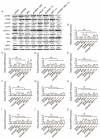Photodynamic Priming Improves the Anti-Migratory Activity of Prostaglandin E Receptor 4 Antagonist in Cancer Cells In Vitro
- PMID: 34771424
- PMCID: PMC8582354
- DOI: 10.3390/cancers13215259
Photodynamic Priming Improves the Anti-Migratory Activity of Prostaglandin E Receptor 4 Antagonist in Cancer Cells In Vitro
Abstract
The combination of photodynamic agents and biological inhibitors is rapidly gaining attention for its promise and approval in treating advanced cancer. The activity of photodynamic treatment is mainly governed by the formation of reactive oxygen species upon light activation of photosensitizers. Exposure to reactive oxygen species above a threshold dose can induce cellular damage and cancer cell death, while the surviving cancer cells are "photodynamically primed", or sensitized, to respond better to other drugs and biological treatments. Here, we report a new combination regimen of photodynamic priming (PDP) and prostaglandin E2 receptor 4 (EP4) inhibition that reduces the migration and invasion of two human ovarian cancer cell lines (OVCAR-5 and CAOV3) in vitro. PDP is achieved by red light activation of the FDA-approved photosensitizer, benzoporphyrin derivative (BPD), or a chemical conjugate composed of the BPD linked to cetuximab, an anti-epithelial growth factor receptor (EGFR) antibody. Immunoblotting data identify co-inhibition of EGFR, cAMP-response element binding protein (CREB), and extracellular signal-regulated kinase 1/2 (ERK1/2) as key in the signaling cascades modulated by the combination of EGFR-targeted PDP and EP4 inhibition. This study provides valuable insights into the development of a molecular-targeted photochemical strategy to improve the anti-metastatic effects of EP4 receptor antagonists.
Keywords: antibody-drug conjugate; ovarian cancer; photodynamic therapy; photoimmunotherapy; prostaglandin inhibitor.
Conflict of interest statement
The authors declare no conflict of interest.
Figures






Similar articles
-
A new nanoconstruct for epidermal growth factor receptor-targeted photo-immunotherapy of ovarian cancer.Nanomedicine. 2013 Oct;9(7):1114-22. doi: 10.1016/j.nano.2013.02.005. Epub 2013 Feb 26. Nanomedicine. 2013. PMID: 23485748 Free PMC article.
-
Breaking the selectivity-uptake trade-off of photoimmunoconjugates with nanoliposomal irinotecan for synergistic multi-tier cancer targeting.J Nanobiotechnology. 2020 Jan 2;18(1):1. doi: 10.1186/s12951-019-0560-5. J Nanobiotechnology. 2020. PMID: 31898555 Free PMC article.
-
Towards Photodynamic Image-Guided Surgery of Head and Neck Tumors: Photodynamic Priming Improves Delivery and Diagnostic Accuracy of Cetuximab-IRDye800CW.Front Oncol. 2022 Jun 28;12:853660. doi: 10.3389/fonc.2022.853660. eCollection 2022. Front Oncol. 2022. PMID: 35837101 Free PMC article.
-
Cetuximab: an epidermal growth factor receptor chemeric human-murine monoclonal antibody.Drugs Today (Barc). 2005 Feb;41(2):107-27. doi: 10.1358/dot.2005.41.2.882662. Drugs Today (Barc). 2005. PMID: 15821783 Review.
-
Cyclooxygenase-2-prostaglandin E2-eicosanoid receptor inflammatory axis: a key player in Kaposi's sarcoma-associated herpes virus associated malignancies.Transl Res. 2013 Aug;162(2):77-92. doi: 10.1016/j.trsl.2013.03.004. Epub 2013 Apr 6. Transl Res. 2013. PMID: 23567332 Free PMC article. Review.
Cited by
-
Exploiting Unique Features of Microneedles to Modulate Immunity.Adv Mater. 2023 Dec;35(52):e2302410. doi: 10.1002/adma.202302410. Epub 2023 Nov 5. Adv Mater. 2023. PMID: 37380199 Free PMC article. Review.
-
Photodynamic priming modulates cellular ATP levels to overcome P-glycoprotein-mediated drug efflux in chemoresistant triple-negative breast cancer.Photochem Photobiol. 2025 Jan-Feb;101(1):188-205. doi: 10.1111/php.13970. Epub 2024 Jun 2. Photochem Photobiol. 2025. PMID: 38824410 Free PMC article.
-
Transient fluid flow improves photoimmunoconjugate delivery and photoimmunotherapy efficacy.iScience. 2023 Jun 26;26(8):107221. doi: 10.1016/j.isci.2023.107221. eCollection 2023 Aug 18. iScience. 2023. PMID: 37520715 Free PMC article.
-
Critical PDT Theory III: Events at the Molecular and Cellular Level.Int J Mol Sci. 2022 May 31;23(11):6195. doi: 10.3390/ijms23116195. Int J Mol Sci. 2022. PMID: 35682870 Free PMC article. Review.
-
Engineering photodynamics for treatment, priming and imaging.Nat Rev Bioeng. 2024 Sep;2(9):752-769. doi: 10.1038/s44222-024-00196-z. Epub 2024 Jun 19. Nat Rev Bioeng. 2024. PMID: 39927170 Free PMC article.
References
-
- De Silva P., Saad M.A., Thomsen H.C., Bano S., Ashraf S., Hasan T. Photodynamic therapy, priming and optical imaging: Potential co-conspirators in treatment design and optimization—A Thomas Dougherty Award for Excellence in PDT paper. J. Porphyr. Phthalocyanines. 2020;24:1320–1360. doi: 10.1142/S1088424620300098. - DOI - PMC - PubMed
-
- Snyder J.W., Greco W.R., Bellnier D.A., Vaughan L., Henderson B.W. Photodynamic Therapy: A Means to Enhanced Drug Delivery to Tumors. Cancer Res. 2003;63:8126–8131. - PubMed
-
- Wang Y., Gonzalez M., Cheng C., Haouala A., Krueger T., Peters S., Decosterd L.-A., van den Bergh H., Perentes J.Y., Ris H.-B., et al. Photodynamic induced uptake of liposomal doxorubicin to rat lung tumors parallels tumor vascular density. Lasers Surg. Med. 2012;44:318–324. doi: 10.1002/lsm.22013. - DOI - PubMed
-
- Wang X., Gronchi F., Bensimon M., Mercier T., Decosterd L.A., Wagnières G., Debefve E., Ris H.-B., Letovanec I., Peters S., et al. Treatment of pleural malignancies by photo-induction combined to systemic chemotherapy: Proof of concept on rodent lung tumors and feasibility study on porcine chest cavities. Lasers Surg. Med. 2015;47:807–816. doi: 10.1002/lsm.22422. - DOI - PubMed
Grants and funding
LinkOut - more resources
Full Text Sources
Research Materials
Miscellaneous

